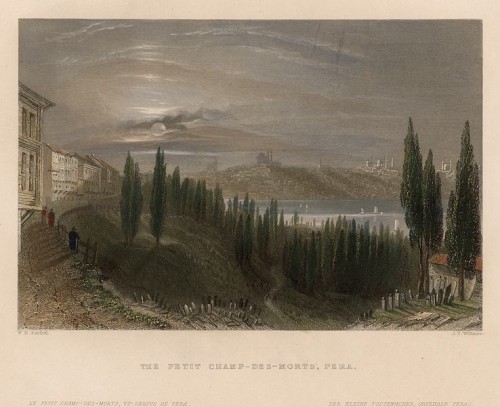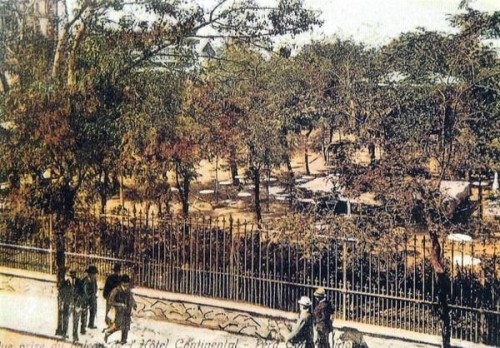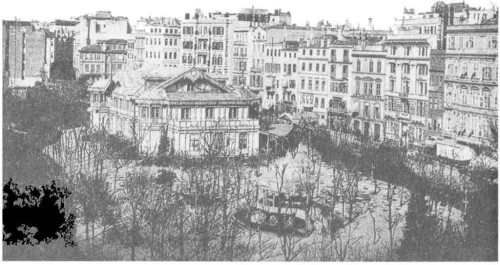
“In that place there were no train stations, crowded ferries, or boulevards where everyone bumped into each other as they walked. There were no lampposts, bridges, or towers either. Everything consisted of a great meaning. One part of that meaning was haste, the other part was agitation. Every tiny thing was a reflection of that greater meaning. Drawn curtains, leaving the workplace at the end of the working day, and the squares where lovers arranged to meet, were all reflections of it. If it rained, and washed and cleansed the city’s dirt for days, it would still be that meaning that emerged with the first ray of sunshine. Time that ticked on in maternity hospitals, in back streets and in late night bars, toyed with the city’s pace. People forgot the sun, the moon, and the stars and lived only with times. Time for work, time for school, time for an appointment, time to eat, time to go out. When it was finally time to sleep, people had no more strength or desire left to think about the world. They let themselves go in the darkness. They were dragged along by a single meaning, a meaning that was hidden in every single thing. What was that meaning and where was it taking us? People created small pleasures for themselves to stop their minds from clouding over with such questions, and chased after them relentlessly. They ran away from life’s hardships, slept peacefully, and thus lightened their minds’ burden. And their hearts’. They believed that. Until a wall inside them came crashing down and their hearts were crushed.” ― Burhan Sönmez, Istanbul, Istanbul
I am back in Taksim. The first book I read since I moved to ANAMED is Burhan Sönmez’s Istanbul, Istanbul, a great choice as it turns out considering my state of mind. I feel like a total stranger, yet I have been here for a long time. I feel like I know this place, or I used to know. What happened? Something happened to me or to Taksim? The obvious answer seems to revolve around Taksim at first, but it is not. Something happened to both of us.
When I started thinking about writing on Taksim for this blog, to decide which one of Taksim’s changing faces and which one of Zeyneps I would focus on puzzled me. I then decided that I would divide my story into three phases and name each epoch something different, in a very Ranke-an style. Then, I realized there was no beginning and no end to those phases, they have been growing organically and melding in together. Taksim and I grew together. Now we are getting old together.
I remember that day very vividly when I set foot on Istiklal Street for the first time, almost twenty years ago now. I remember what I was wearing, how I was feeling. I remember exactly. I was wearing a pistachio green tricot top, beige linen trousers and a velvet purple bag, my coolest outfit then. Street children welcomed us at the entrance of Istiklal begging us to buy paper tissues. “This is not so different from Izmir,” I thought. As we blended in the sea of thousands-heads, I was amazed by the cosmopolitanism, the variety of people and styles, some of them so marginal that I remember forcing myself not to stare. That was me, 17 year-old Zeynep from Izmir who came to Istanbul for the first time without the company of her parents and who at that time had a very limited vocabulary of people, their different faces and emotions (and, as I understand it now, to my imagination they were only positive). That Zeynep believed she would take over the city, but instead chaos took over her, eventually.
As we passed by Galatasaray High School, there was hardly anybody left on the street. We wanted to go to Babylon in Tünel to see a concert, the coolest bar and concert venue that had recently opened. At that time in the Tünel area, there was only another bar, “Badehane” and a meyhane, “Refik”. As we were walking on the desolate Istiklal, a couple approached us and asked if we would want their company so that nobody would disturb us. Reflecting upon that very first evening, it was beyond my imagination to see how fast and abruptly this area was going to change only within a couple of years. At that time, I knew very little about the city, I mean its true essence and character. It was only years later that I firmly understood that this is what Istanbul does. It changes constantly. It consumes people and places, not the other way around. Istanbul does that in order to stay alive.
In the 2000s Tünel area became so popular that it was like a huge street party everyday. In order to advance in the crowd, you just had to dive into the huge wave of people and move along. It was as if we were collectively forming a giant beast. Its arms and legs were flowing into the side streets and altogether spreading over the whole Tünel area. We were able to coexist harmoniously, ready to take on the night before it devoured us. A few years later, there was a ban. Bars and restaurants had to remove their tables from the sidewalks. First, the beast and then the life in the street died. Bars and restaurants started to shut down one by one. Tünel became desolate once again, but this time desolate in a somehow different way.
The history of Tünel area as I experienced it for the last twenty years is only a very tiny part of the story when one thinks of many other transformations the area has gone through over time, similar to my story, and similar to the story of my relationship with Taksim. During our first week at ANAMED, I took part in the historical Beyoğlu tour. In fact, I ran into the tour as I was stepping out of the building. The reason for this is that I had thought I already knew so much about the area. Needless to say, I was completely wrong. To give one example, our guide Cemil Bezmen mentioned the Tepebaşı Park, which used to be located on what is now a concrete terrain with a parking lot on and underneath, a cafe at the edge and the national public TV channel that dominates the view. The Park came into being as a result of the construction of the Tünel, one of the world’s oldest (and shortest) underground funicular line, as it was filled by the earth excavated from the construction site. The Tünel was inaugurated in 1875. I do not know if it is an urban legend but I had heard that the first privileged passengers on board were animals (perhaps not so privileged when one thinks that this was done so to convince the public of the railway’s safety). After some research, I found out that before the Park, this area, a steep valley overlooking the Golden Horn, was a cemetery up until the mid-nineteenth century and therefore was known as “Petit Champ-des-Morts”.

The Tepebaşı Park (Source unknown)
After the completion of the Park, a theatre building was also constructed on this site circa 1890. The theatre, later came to be known as “Tepebaşı Dram Tiyatrosu”, continued to host theatregoers until 1969 and was completely destroyed as a result of two consecutive fires that broke out in 1970 and 1971. (*)

The Tepebaşı Dram Theatre (Source: https://saribegum.wordpress.com/2018/03/11/theme-proposal-and-searches-for-istanbul-tepebasi/)
This brief and simplified history of Tepebaşı certainly leaves out many small and individual histories of this area. But after having spent almost twenty years here and realizing only now that I knew nothing about the history of this small quarter of Pera came to me as a shock, even more so as a historian. This piece is therefore dedicated to the memory of those who are buried in the “Petit champ-des-morts”, those who laughed and shed tears in Tepebaşı Theatre and those who once turned into one giant beast at nights in Tünel.
(*) http://tiyatromuzesi.org/drupal/tepebasi_dram_tiyatrosu.html
Sources:
http://tiyatromuzesi.org/drupal/tepebasi_dram_tiyatrosu.html

